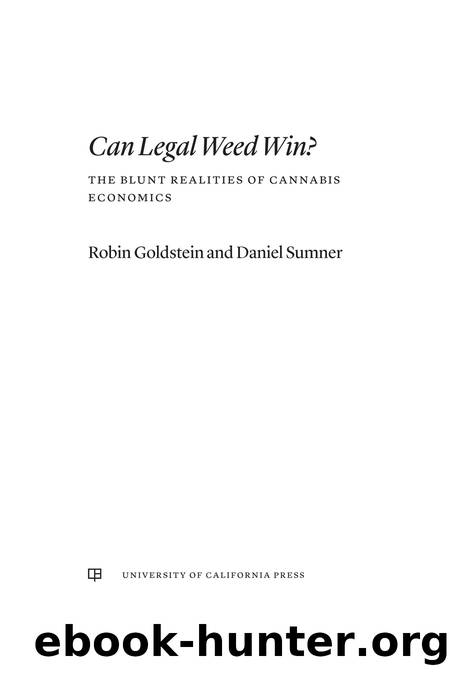Can Legal Weed Win?: The Blunt Realities of Cannabis Economics by Robin Goldstein & Daniel Sumner

Author:Robin Goldstein & Daniel Sumner [Goldstein, Robin & Sumner, Daniel]
Language: eng
Format: epub
Tags: Business & Economics, Economic History, Economics, Microeconomics, Public Finance, General, Theory, Law, Legal History, Medical Law & Legislation
ISBN: 9780520383265
Google: C-FfEAAAQBAJ
Publisher: Univ of California Press
Published: 2022-06-14T20:36:42+00:00
A New Coalition Arises, Then Fragments
After the 2010 loss, the proâProp 19 coalition re-formed and expanded to plan for a 2016 initiative. Leaders of Californiaâs prolegalization groups met on a regular basis to discuss and work out the details of a new ballot initiative and campaign strategy. Dubbed the âCoalition for Cannabis Policy Reformâ (CCPR), the new group was led by Prop 19 campaign director Dale Sky Jones, Cal NORML director Gieringer, and some attorneys, consultants, and representatives of Californiaâs legal medical weed industry, including Steve DeAngelo, founder of Oaklandâs famous Harborside dispensary. For the sake of branding and brevity, CCPR dubbed their initiative campaign âReformCA.â There were a lot of weed-savvy people in the group, a lot of big egos at the table, and a lot of different ideas.
A common understanding developed within the group that 2016 would be the year for the next initiative. But that was about the only thing the growing group of weed luminaries could agree on. By mid-2015, things had started getting weird, and the prospect of getting the necessary signatures still seemed distant. A rival group, led by Lynne Lyman of the Drug Policy Alliance (DPA) and Graham Boyd of the New Approach political action committee, broke away from the ReformCA coalition and began working on an initiative of their own. On almost every major aspect of the statutory material being drafted, DPA disagreed with the ReformCA approach.
DPA was a national organization that had supported ballot measures in other states, and they came in with significant money. Gieringer says that the DPA approach was to try to put a weaker legalization initiative on the California ballotââweakâ meaning conservative, restrictive, and making concessions to whatever groups were necessary to achieve success (even if the laws resulted in excessive obstacles for businesses to enter the legal recreational market). DPA and like-minded allies wanted to assure the largest possible electoral margin for recreational legalizationâregardless of the downstream consequences.
After the defection of DPA, a major rift developed in the whole community of cannabis activists in California who wanted an initiative on the 2016 ballot. Some people switched sides. Close friends were competing to raise money from the same sources for different organizations with the same stated purpose. At one point it looked like there might actually be two rival legalization initiatives on the ballot, as sometimes occurs in California. That would have meant befuddled voters, chaos in the media, and the likely failure of both initiatives.
Getting a proposition on the California ballot is typically just a matter of hiring a huge army of young people to stand around shopping malls and street corners and go door to door to get citizens to sign a nice-sounding petition about which they generally have no clue. But it takes millions of dollars to do that. As 2016 approached, with support split, neither ReformCA nor the DPA group was raising enough money to get the needed signatures.
To get on the 2016 ballot, either of the pro-weed interest groups would have needed
Download
This site does not store any files on its server. We only index and link to content provided by other sites. Please contact the content providers to delete copyright contents if any and email us, we'll remove relevant links or contents immediately.
International Integration of the Brazilian Economy by Elias C. Grivoyannis(86579)
The Radium Girls by Kate Moore(11873)
Turbulence by E. J. Noyes(7901)
Nudge - Improving Decisions about Health, Wealth, and Happiness by Thaler Sunstein(7469)
The Black Swan by Nassim Nicholas Taleb(6953)
Rich Dad Poor Dad by Robert T. Kiyosaki(6324)
Pioneering Portfolio Management by David F. Swensen(6175)
Man-made Catastrophes and Risk Information Concealment by Dmitry Chernov & Didier Sornette(5883)
Zero to One by Peter Thiel(5643)
Secrecy World by Jake Bernstein(4599)
Millionaire: The Philanderer, Gambler, and Duelist Who Invented Modern Finance by Janet Gleeson(4306)
Skin in the Game by Nassim Nicholas Taleb(4128)
The Age of Surveillance Capitalism by Shoshana Zuboff(4125)
The Money Culture by Michael Lewis(4033)
Bullshit Jobs by David Graeber(4000)
Skin in the Game: Hidden Asymmetries in Daily Life by Nassim Nicholas Taleb(3873)
The Dhandho Investor by Mohnish Pabrai(3642)
The Wisdom of Finance by Mihir Desai(3612)
Blockchain Basics by Daniel Drescher(3435)
